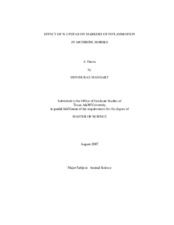| dc.description.abstract | Sixteen horses with at least one arthritic joint were randomly divided into two
groups. The control group (n=8) was fed a control ration at 1% BW in grain. The
treatment group (n=8) was fed an isocaloric diet similar to the control diet with
additional n-3 polyunsaturated fatty acids (PUFAs) in the form of two pelleted
supplements. Coastal hay was fed free choice, and both groups consumed their
respective diet for 90 days.
On d 0, 30, 60, and 90 synovial fluid was collected from one arthritic joint on
each horse, and blood samples were collected every 15 days. Synovial fluid was
analyzed for Tumor Necrosis Factor-α, Interleukin-1, and white blood cell
concentration, and plasma was analyzed for fibrinogen and Prostaglandin E2. Force plate
analysis was used to determine changes in weight distribution throughout the trial.
Fatty acid analysis revealed the main n3 supplied by the supplements was
docosahexaenoic acid (C22:6n3). Treatment horses consumed 9.3 g docosahexaenoic
acid daily, while control horses consumed only 0.42 g daily. A reduction in concentrate
intake also allowed treatment horses to consume 25.45 g less of linoleic acid (C18:2n6)per day. Excluding hay, the n6:n3 ratio of the treatment diet was 5:1 compared to the
control diet with a ratio of 11:1. Analysis of plasma fatty acid profiles revealed
treatment horses experienced an increase in plasma docosahexaenoic acid, along with a
decrease in linoleic acid (C18:2n6). Total plasma n6:n3 ratio of treatment horses was
23:1, as opposed to 27:1 in the control horses.
Treatment horses had significantly lower synovial fluid white blood cell
concentration and plasma Prostaglandin E2 (P < 0.05). A trend towards decreased
fibrinogen (P = 0.076) was also seen in the treatment horses. Synovial fluid TNF-α and
IL-1 concentrations were not obtained due to problems with the assay kits or procedures.
Force plate data from seven horses was analyzed. No significant increase in weight
placed on arthritic limbs (P = 0.12) was seen.
This data provides further evidence that a decrease in the n6:n3 ratio of the diet
and plasma can lead to a decrease in the production of inflammatory compounds in
arthritic joints. | en |


